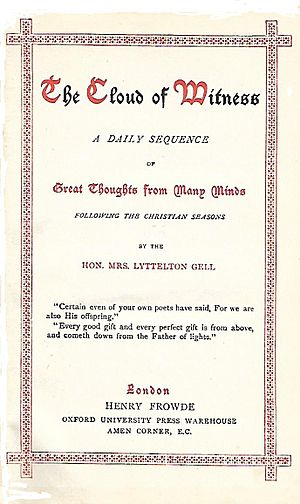Edith Mary Gell facts for kids
Edith Mary Gell (born Brodrick; 1860–1944) was a talented writer and a Christian activist. She was also known by other names like Edith Lyttleton Gell and Edith Brodrick Gell.
Contents
Her Family and Life
Edith Mary Gell was born in 1860. She was the fourth daughter of William Brodrick, who was the 8th Viscount Midleton. Her mother was Augusta, daughter of the 1st Baron Cottesloe.
Edith had a brother named William St John Fremantle Brodrick. He later became the 1st Earl of Midleton (1856–1942). He was a very important politician. He served as the Secretary of State for War from 1900 to 1903. After that, he was the Secretary of State for India from 1903 to 1905.
Edith married Philip Lyttleton Gell (1852–1926) on July 25, 1889. They did not have any children. Edith Gell passed away on April 17, 1944.
What She Was Known For
Edith Gell was very active in her local community. She helped many families through an organization called the Mothers' Union. She also led a Sunday morning service for children. She continued this work almost until she died in 1944.
People have compared her activities to characters in the TV show Downton Abbey. This shows how involved she was in society.
The National Archive describes Edith Gell as a tireless writer. She wrote many devotional poems, hymns, and moral stories. She strongly believed in traditional family values. She was a key member of groups like the Mothers' Union and the Union of Women Workers.
Edith was also very interested in church matters in Derbyshire. She was involved with the churches in Carsington and Wirksworth. She often shared her writings with her family and friends. Later, her memoirs, called 'Under Three Reigns', reached a much wider audience.
Her Social Connections
Because Edith Gell came from an aristocratic family, she knew many important people. She wrote about these interesting connections in her autobiography, Under Three Reigns.
Meeting Queen Victoria
When Edith got married, she was presented to Queen Victoria. She described her experience at court. She said that entering the Throne Room was very grand. Ladies had their long dress trains spread out. There was a large mirror to help them walk gracefully. The walk had to be slow because of the trains.
If you were a Peeress (a noblewoman), the Queen would embrace you. If not, you would kiss her hand. You had to remember to put your hand under her wrist to make the bow look nice. If you were quick, you could bow to other important royals too. After that, an usher would quickly fold your beautiful train over your arm. Then you would leave the room walking backward.
Friend of Alfred Tennyson
Edith and her husband were friends with the famous poet Alfred Tennyson. She shared some stories about him.
Tennyson lived nearby and sometimes came to garden parties. He did not like being treated like a celebrity. So, he would often say very ordinary things to avoid people gushing over him.
Once, in the tea-room, he turned to Edith's mother while holding a ham sandwich. He surprised her by asking, "How do you cure your ham?" She replied that it was salted in the usual way. Tennyson then exclaimed, "Oh! but that is all wrong!" He said it should be soaked in treacle and then smoked. He mischievously added, "This is like eating my old boots!"
He had been bothered so much by people that he found being a bit rude was the only way to protect himself. But in his own home, he was different. Lady Tennyson was related to Edith's husband. After they married, Edith and her husband visited them. Tennyson had his moods, like all geniuses, but once you got to know him, he was fine.
Images for kids



